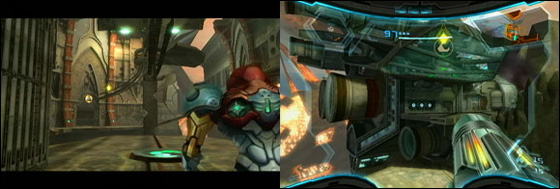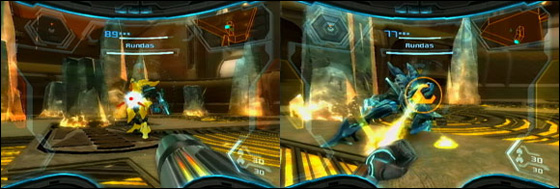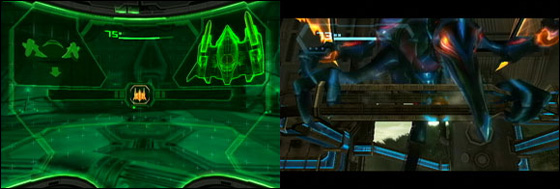Metroid Prime 3: Quarterly Diaries #2
October 1st, 2009

Areas Covered: Cliffside Airdock, Firey Airdock
Discussion Points: Phazon subtext, Bryyo level design, Half-life 2 comparison, backtracking, environment design, Rundas boss battle
Ok, it looks like this series of posts won’t be all that quarterly, but that’s okay. Last time I discussed Metroid Prime 3‘s opening tutorial levels on Olympus and Norion. After being flanked by Meta Ridley and Dark Samus, Samus awakens back on Olympus equipped with the new PED suit, setting out for Bryyo. This post shall concentrate on the Bryyo portion of the game.
Bryyo – Cliffside Airdock
The pragmatic purposes of hyper mode from the newly-acquired PED suit require no real explanation; it’s a new feature implanted into Samus’ suit which allows for a temporal power overload by delivering rapid boosts of Phazon. There’s a subtext here. With the substance now integrated into her suit and utilized freely, Samus and the federation (see: PED-suited soldiers), like the pirates before them, are resorting to Phazon in order to hold their ground in the continual power struggle. The trilogy has slowly edged towards a more accommodating view of Phazon. What was once feared in Metroid Prime and Metroid Prime 2 as a dangerously potent catalyst is now a natural resource; a product of necessity. The good guys have struck a deal with the devil and with Phazon comes Dark Samus; it’s by this association that you know the narrative is going to soon smack into calamity.
As a gameplay device, hyper mode only makes its presence noticed about 4/5ths of the way through Bryyo. It’s a superfluous room clearer in the meantime, which is all well and good, really, because it takes a back suit to the fact that…
…Bryyo as a whole is very well designed. To be honest, I immediately lost wind of of the objectives handed to me and just became consumed by the process of following the rhythmic flow of progression, flagging relevant points of interest for my eventual return. The series has this uncanny ability to immerse the player into its world by designing around the player’s inner psyche. You rarely have to think your way through a Metroid game, progression just comes naturally because clues are put in logical – yet never obvious – places. The scan visor, of course, aids heavily in this process but never feels like cheating, it’s just part of the exploration process. People have made the same commentaries about the recent Batman: Arkham Asylum. The cohesion of the scan visor, play-centred level design and natural-earth aesthetic elicit Metroid’s strongest emotional trigger, being the feeling of unaided realization and discovery of the environment around you. The series, right from start up throws the player into this highly rhythmic mental slumber. In regards to Bryyo, I lapsed into this state (hardcore) for the first time in Metroid Prime 3 in Bryyo, conjuring up those feelings of previous games. Retro Studios don’t let up.

The most fascinating thing about the free form exploration is that it’s all intentional. You might feel like a genius for discovering some secret cavern at the back of the level, but the reality is, you were always meant to find it – that’s how they designed the game.
(Contrast this to the Half-life series which at times does a bloody awful job at stringing the player along. As I mentioned in my previous posts, the episodes did better, but playing Metroid Prime 3 only reasserts how poor the player guiding in the Half-life games truly were. Either game still has nothing on Super Metroid which flourishes astoundingly in this regard. On the other hand, the Metroid level design is constricted in contrast to Half-life‘s selection of open expanses. This changes the dynamic – maybe I shouldn’t make the comparison.)
The centre piece of the Cliffside Airdock area (Gateway) is a great example of this design. It’s a multidirectional entranceway, where, of course, there is only one linear path, but because the branched paths are blocked in such a seemingly natural way (ice blockages, wide abysses, falled debris; they really just disguise the fact that you don’t have X progressional power-up yet) it never feels closed off, just unattainable for the meantime.
The first weapon upgrade for this area is the grapple beam. It’s a nice choice to offer early on as the highly mobile swinging mechanic plays into the new-found fluidity in controls. After attaining it you head back to the Gateway area, follow the next stream of corridors, which you couldn’t previously access without the grapple beam, complete an objective, backtrack to the ship and then fly to the next area.
Firey Airdock
The course of the next area (Firey Airdock) adopts the same travel path; penetrate the level as far as possible, acquire new power-up (in this case the ice beam), backtrack to ship, fly to back to the other area, with aid of new power-up mine a little further, go back and do it all again. In fact, this formula is pasted throughout the entire Bryyo area, occasionally interluded by convenient landing zones for your ship. Ultimately then the same amount of backtracking as prior games ensues, albeit in smaller doses. Doesn’t this demean the convenience of the segregated areas preventing excessive amounts of backtracking? The ship does alleviate a good deal of backtracking, true, yet Retro, at least in Bryyo, don’t treat each section as a single chunk of gameplay, rather they’re a series of islands which must be mined back and forth. It’ll be interesting to observe if the other planets are designed in this manner too.

In contrast to the (Cliffside Airdock area’s) similarities with the Aether overworld from Metroid Prime 2, the visual theme of the Firey Airdock area is akin to Magmoor Caverns from Metroid Prime. Pleasantly though, either locale never feels borrowed, derived or too familiar. The Cliffside Airdock area music doesn’t have the thunderous presence of its forebearer, rather it’s a historically lived-in site with signs of cultural prestige and social functionality. The Firey Airdock area is more industrious than Magmoor Mines with elaborate mechanical puzzles operated by a volatile, yellow jelly.
By this stage Retro have well warmed the seat for the player. The puzzles and level design are instinctive and easily on par with the rest of the series, only aided by the fluidity of the controls. The controls, mixed with the streamlining (such as flicking through visors and only having one beam) remove the baggage of the previous games and allow the player to freely dive into business. Further examples of the clever interfacing are seen in the landing site puzzles up ahead.
I ought to talk about the Rundas boss battle first though. I found this confrontation to be rather awkward. Three things contribute to this; firstly, the playing space is cluttered by an excesses of frozen spires. They’re simply difficult to weave around when your target – and hence viewpoint – is directed towards the sky and not the ground. Secondly, Rundas moves too fast when in flight mode and often spins in circles. It occasionally seems as though the path finding is muddled. Lastly, the design of the environment is over contrasted by the imposing yellow sky which you are forced to point towards.

On the other hand, the battle utilized the tugging of the grapple well and moved between a series of play states; in the air, on the ground, attacking and defending which kept momentum continuous and the battle engaging.
Additional Readings
Metroid Prime Trilogy Review – Eurogamer
Metroid Prime 3: Quarterly Diaries #1
September 29th, 2009

For the prelude to this article, please click here. I’m going to be jumping a lot between fully fledged observations rather than writing in a progressive walkthrough format as I originally proposed. So it’s more like; this topic was relevant at this part of the game, and up to now here are my thoughts on this relevant topic. I also intend to talk predominately about the pragmatic features of the game, rather than the actual goings-on (ie. what you do, what happens in the narrative). This post has evolved into something else entirely, so I’ve broken it into two. The next one will arrive shortly.
Areas Covered: Samus’ Ship, Olympus Space Station, Norion
Discussion Points: Samus’ Ship functionality, the extended cast, the tutorial functions, interplay with the cast, grapple lasso, Meta Ridley
Samus’ Ship
You begin Metroid Prime 3 in the cockpit of Samus’ spaceship. Interfacing with Samus’ ship is one of the new features to Metroid Prime 3, so using it as an initial starting point was probably a wise decision. Effectively it’s meant to act as the centre point of the game’s hub in which Samus can planet-hop through the galaxy, but due to the limited destinations it initially doesn’t present itself in such a manner and feels largely worthless. Most of the ship’s utilities seem pretty immaterial too. Oh, that is besides the cool gimmicks, of course.
Olympus Space Station
Samus soon departs to the Olympus space station. This is an interesting area because it’s unusually full of people. I don’t mean literally full of people, they’re actually pretty sparse and don’t really converse anything of merit – but people, in a Metroid game. It’s a little bizarre. The Metroid games have always been about isolation and Metroid Prime 3‘s attempt to branch out into, both the figurative and literal, social sphere of the universe is an awkward fit. What are all you stand-in space folk doing in my Metroid game? Shoo! The space station, just like the ship, rather quickly familiarizes players with these new, superfluous additions. That isn’t to be too discrediting though. Retro Studios, so far (as in 25% progression), has done an admirable job at handling them, but that doesn’t prevent these features from providing unnecessary friction against the rest of the game.

I’m hesitant to say whether Olympus Space Station acts as the game’s tutorial or not. It isn’t until after the events on Norion where the game properly begins. It’s akin to Metal Gear Solid 3 in this regard, the Virtuous Mission is obviously the tutorial, but the game doesn’t really open until after the Ocelot battle once you’ve retraced your footsteps – there’s a bit of suspension in between.
The space station more or less suits you up everything pre-MP3, whilst setting the precedence for the conflict. You learn the basics of moving, shooting and morph-balling, acquire missiles, meet some savage space pirates and down a boss. It’s not until after Norion that you’ll gain the PED suit and grapple lasso; the latest additions to the bounty hunter’s repertoire. Narrative-wise it’s the same, the Olympus Space Station sets the scene, Norion takes the next appropriate steps and acquaints you with the rival bounty hunters and the treacherous Dark Samus.
Norion
Norion is interesting as the primary objective (objectives are provided frequently by the Galactic Federation) is shared among Samus and the collective group of other bounty hunters. The team must reactivate three turret generators to fight off a wave of incoming space pirate fleets. One might assume that Samus, as the player, performs all the work for the team (as tends to be the case in most video games) but in actuality she completes her objective while frequently, and seamlessly, aiding the other members. There’s clear cross over as the other hunters interlude with your progress, passing the rod and covering your back. This gives Retro breathing room to introduce the various members as they portray their distinctive personalities. In later levels the bounty hunters become “corrupted”, forming the core boss encounters of the game. This initial method of introduction is clever then as it plants the seeds for what’s to come.

The grapple lasso is the key new mechanic for this isolated chapter of gameplay. The lasso is a perfect fit for Metroid Prime 3, made better by the tugging sensation from the Wii nunchuck. The lasso surprisingly lends itself to a host of action (not just rounding up space pirates, well ok, you can’t do that either) such as removing debris or ripping shields from space pirates. Very satisfying. The new visor for commanding Samus’ ship is also used briefly, I’m yet to be convinced though.

Near the end of the Norion level we’re spoilt by the appearance of Meta Ridley. He makes a brief stint as Samus is making her way to the final generator traveling through a metal frame in morphball-mode. Ridley clings onto the frame and tries to chew his way through. He’s just there to spook you though and it nicely crescendos into the next spate of space pirate attack and then finally into the proper confrontation with Ridley. This sequence is a little rough around the edges, but mostly achieves its desired sense of thrill. Firstly though, Ridley’s entrance is brilliant and if it wasn’t for it’s earlier showing in E3 demos, I would have probably been blown out of my seat. The boss situation is equally so, seeing Samus and Ridley in hot pursuit as they fall down a hazardous shaft. The execution is a little wonky as the battle plays out in two heavily controlled spaces; either falling face first, avoiding oncoming debris, or in the tight grip of Ridley’s claw. The transitions between each are a little awkward as the first person viewpoint tries to orientate itself around the action. It’s a little jarring but a momentous battle all the same.
Gameplay Images Taken From IGN Guides
Metroid Prime 3: Quarterly Diaries (Prelude)
September 27th, 2009

I’m sensing that — with articles such as the ones I’ve written on the PSP Syphon Filter games, Prince of Persia, Zelda: Twilight Princess and the Half-life series — I’m slowly leaning in favour of longer, more exhaustive pieces of writing on a single game or series. And I quite like it!
Although I’ve tried and failed twice, almost three times before (check the Final Fantasy Marathon, Syphon Filter: LS walkthrough and GTA: CW Cross Blog Dialogue) I’d like to once again try journaling my game progression and observations into a more-than-one-part series of posts. You know, the walkthough format where I spout out observations relative to my completion rate. This time I’d like to give it another red-hot go with Metroid Prime 3: Corruption.
I chose Metroid Prime 3 for two reasons. Firstly, I hold the sub-series in high regard. Metroid Prime being a deeply engaging experience, one that reinvigorated my eagerness towards this medium in the way that only the best games can. The level of artistry on all fronts was and will always be truly impeccable, Retro Studios have a craftmenship like no other.
The second reason is not so honourable. I bought MP3 back on release (came with a $20 guide too, not bad for $69, inclusive) and joyfully began playing it, reached 20%, then stopped. Tried again and was disrupted. A week later, I finally started again for the (ironical) third time, this being the play through I shall monitor.
Before I get into the discussion though I wish to prelude with some preliminary objectives;
Piecing Together the Trilogy
I’d played the prior two games excessively – as I usually did with games at the time. This has given me a decent understanding of the previous games, so with this knowledge, I hope to piece together the trinity of themes which each title represents. I obviously have strong ideas on the earlier two games, therefore playing MP3 will allow me to conclude the my thoughts on the trilogy as a whole.
Trueness to the Original Series
I’m also playing through Super Metroid simultaneously and am therefore interested in grading MP3 on how well it maintains the Metroid-ness of the series. How pure it is to series lore? And how do Retro Studios handle expansion and divergences? This is particularly interesting for MP3 as it’s already been preceded by two other Metroid Prime games, hence it needs to establish some individuality within the proven formula, as Metroid Prime 2 did before it.
Interface
Streamlining. This is a Wii game after all – how well does the game accommodate the new control scheme via interface?
Fresh, Stale, Corrupt?
How well does Metroid Prime 3 maintain that new game smell in a sub-series which is already at it’s peak?
Sub-Series Regulars
Dark Samus and Phazon both originated in Metroid Prime. Maybe, just like the Matrix trilogy, there is a life, birth and death metaphor going on. Maybe not. I’m intrigued at how this title will close these elements. Phazon seems legit, but Dark Samus is still a bit of a dubious character. I’d like to draw comparisons with the less dubious SA-X from Metroid Fusion too.
Additional Readings
Retro Studios Tour – IGN Video
Metroid Prime Trilogy Video Game, Developer’s Voice Featurette



 Game Design Companion: A Critical Analysis of Wario Land 4 - $7.99
Game Design Companion: A Critical Analysis of Wario Land 4 - $7.99 Level Design: Processes and Experiences
Level Design: Processes and Experiences Speed Boost: The Hidden Secrets Behind Arcade Racing Design - $5.99
Speed Boost: The Hidden Secrets Behind Arcade Racing Design - $5.99 Adventures in Games Analysis: Volume I - $5.99
Adventures in Games Analysis: Volume I - $5.99







